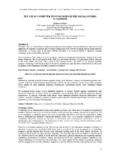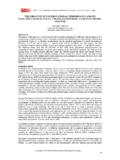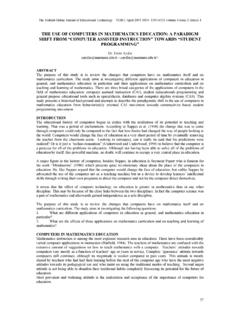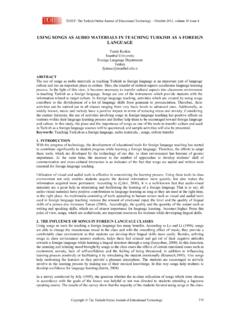Transcription of APPLICATION OF INTERACTIVE MULTIMEDIA …
1 TOJET: The Turkish Online Journal of Educational Technology January 2013, volume 12 Issue 1 Copyright The Turkish Online Journal of Educational Technology 19 APPLICATION OF INTERACTIVE MULTIMEDIA TOOLS IN TEACHING MATHEMATICS EXAMPLES OF LESSONS FROM GEOMETRY Marina Milovanovi , , Faculty of entrepreneurail business, Union University, 62 Cara Du ana str., 11 000 Belgrade, Serbia, MsC Jasmina Obradovi Institute Go a, 35 , Milana Raki a str., 11 000, Belgrade, Serbia Aleksandar Milaji , Faculty of management in civil engeneering,, Union University, 62 Cara Du ana str., 11 000 Belgrade, Serbia, ABSTRACT This article presents the benefits and importance of using MULTIMEDIA in the math classes by the selected examples of MULTIMEDIA lessons from geometry (isometric transformations and regular polyhedra).
2 The research included two groups of 50 first year students of the Faculty of the Architecture and the Faculty of Civil Construction Management. Each group was divided into two groups of 25 students, one of which had the traditional lectures, while the other one had the INTERACTIVE MULTIMEDIA lessons. The main source of information in MULTIMEDIA lectures were the softwares created in Macromedia Flash, with the same definitions, theorems, examples and tasks as well as in traditional lectures but with emphasized visualization possibilities, animations, illustrations, etc.
3 Both groups were tested after the lectures. In the both MULTIMEDIA groups students showed better theoretical, practical and visual knowledge. Besides that, survey carried out at the end of the research clearly showed that students from MULTIMEDIA groups were highly interested in this way of learning. Keywords: MULTIMEDIA learning; MULTIMEDIA lessons; isometric transformations; regular polyhedra. INTRODUCTION Mathematics teachers show great interest in visualization of the mathematical terms and emphasize that visualized lectures are of the great help in developing abstract thinking in mathematics (Bishop, 1989).
4 It is of the major importance to connect the existing pictures that students have on certain terms in order to develop them further and to enable students to accept the further knowledge (Tall, 1991). Therefore, in teaching mathematics it is necessary to combine the picture method and the definition method in order to improve the existing knowledge and to enlarge it with the new facts, which is one of the points of the cognitive theory of MULTIMEDIA learning (Mayer, 2001, 2005). Recent researches on presentation methods in teaching mathematics are focused on testing different visualization methods, such as pictures, two- and three-dimensional animations in order to find the most appropriate and the most understandable ones (Rias, Zaman, 2011).
5 Geometry is the branch of mathematics in which the visualization is one of the most essential elements for understanding presented definitions and theorems, as well as for solving the given tasks and problems. Experience in working with students showed that they find it difficult to imagine the picture of a given problem and that they will be more successful in solving the task if it is adequately presented both textually and visually. Furthermore, if we use the MULTIMEDIA presentation of the problem instead of the picture in order to enable visualization with animated movements in three-dimensional space, solving of the problem will be much easier and more interesting.
6 Numerous authors who have investigated the methodology of teaching geometry have emphasized that it is of essential importance for a teacher to understand students conceptions or misconceptions of important ideas (Glass, Deckert, 2001). It is also important for a teacher to consider various approaches to teaching, to offer activities that probe students understanding, and to analyse students' work (Hollebrands, 2004). Modern methods in MULTIMEDIA learning include the whole range of different possibilities applicable in mathematics lectures for different levels of education and with various INTERACTIVE levels (Hadjerrouit, 2011; Herceg, 2009; Milovanovic, 2005; Milovanovi , Takaci, Milajic, 2011; Taka i, Stojkovi , Radovanovic, 2008; Taka i, Herceg, Stojkovi , 2006; Taka i, Pe i , 2004).
7 These authors suggested using different kinds of software in education. There are several investigations on using software tools in teaching geometry, such as GeoGebra (Bulut, 2011), Geometers Sketchpad (GSP), (Nordin, Zakaria, Mohamed, Embi, 2010) etc. TOJET: The Turkish Online Journal of Educational Technology January 2013, volume 12 Issue 1 Copyright The Turkish Online Journal of Educational Technology 20 All the above-mentioned resulted in an idea of making applicative software which would be helpful in a modern and more interesting approach to the field of teaching mathematics. The purpose of the software was to raise the students knowledge in a field of isometric transformations and regular polyhedra to a higher level.
8 So, the aim of this article is to recognize the importance of MULTIMEDIA in the teaching process as well as to examine the students reaction to this way of learning and teaching. MULTIMEDIA PRESENTATION OF SEVERAL PROBLEMS FROM THE SCOPE OF ISOMETRIC TRANSFORMATIONS AND REGULAR POLYHEDRA MULTIMEDIA lessons presented in this work included isometric transformations (line and point reflection, translation and rotation) and regular polyhedra as the basic fields of the mathematical geometry. These topics are also important because they are being introduced very early in learning mathematics, in the primary school.
9 They are also present throughout the higher levels of education both directly and indirectly, using numerous examples of their implementation. Therefore, studying isometric transformations and regular polyhedral throughout education is one of the most important segments of teaching mathematics. The emphasis was on using computers, MULTIMEDIA software in learning, because animations enable students to see not only the final result of an isometric transformation but also the movement that produced it. Besides that, student can rotate any polyhedron and see it from all sides in order to solve the given task.
10 Assorted examples and problems from MULTIMEDIA lectures on Isometric Transformations Our lectures on isometric transformations (start page shown on Figure 1), consist of four units: line and point reflection, translation and rotation (Milovanovic, 2005). Lesson about every transformation is presented by the following chapters: Basics, Examples, Some characteristics, Exercises, Problems and Examples from everyday life. In creating MULTIMEDIA lessons, special attention was paid to enabling students to find out the solutions individually. Figure 1. Start page of MULTIMEDIA lesson about the Isometric Transformations.





